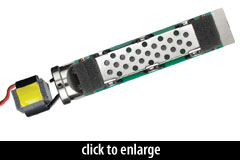 Audio-Technica AT4081
Audio-Technica AT4081
Bidirectional Active Ribbon Microphone
The AT4081 is the less-expensive of of a pair of new phantom-powered ribbon microphones from Audio-Technica.
Introduced in 2009, the AT4080 and AT4081 feature several new ribbon-motor developments. Audio-Technica claims to have 18 patents pending for these new mics.
The motor is a dual-ribbon design. The use of two ribbons can increase the sensitivity of the transducer, as they are wired in series. The two ribbons are mounted front-to-back, with one slightly in front of the magnetic pole and one slightly behind it.
The ribbon motor is mounted behind a resonator plate — a perforated metal plate that is in a sense a hardware EQ device. It is likely responsible for raising the mic’s HF response. Presumably, both sides of the ribbon motor are capped with identical resonators.
As in all modern ribbon mics, the magnets are Neodymium.
 Audio-Technica’s “MicroLinear™ ribbon imprint” is claimed to increase ribbon durability. We speculate that the process behind this feature is described within one or both of the following patent applications:
Audio-Technica’s “MicroLinear™ ribbon imprint” is claimed to increase ribbon durability. We speculate that the process behind this feature is described within one or both of the following patent applications:
- #11/067,929 - Gold plating
The pure aluminum foil used in ribbon microphones is susceptible to corrosion from moisture in the air, resulting in a coating of aluminum hydroxide upon the surface of the ribbon. Further, the bimetallic junction of the aluminum ribbon with its mounts (usually brass) can lead to electrolytic corrosion, increasing the resistance of the circuit and resulting in decreased sensitivity and increased noise.
Coating the ribbon and its junction plates with a thin (500 Angstrom) film of gold can prevent corrosion, without adversely affecting the mass or resonant frequency of the ribbon.
- #12/276,923 - Lengthwise corrugation
 This patent application’s claim appears to be limited to the idea that by corrugating the ends of the ribbon such that the lines are parallel to its length, the ribbon is stiffer and therefore easier to install, and further that the clamping mechanism can form a tighter electrical connection to a surface with “a plurality of stripe-like irregularities,” reducing resistance.
This patent application’s claim appears to be limited to the idea that by corrugating the ends of the ribbon such that the lines are parallel to its length, the ribbon is stiffer and therefore easier to install, and further that the clamping mechanism can form a tighter electrical connection to a surface with “a plurality of stripe-like irregularities,” reducing resistance.Curiously, every illustration in the patent shows that the middle ~80% of the ribbon is also corrugated parallel to its length. This is different from the vast majority of ribbons on the market, which (following the RCA standard) utilize “short” corrugation lines perpendicular to the ribbon’s length. The design in the A-T patent illustration looks identical to the corrugation style of Beyerdynamic’s short-ribbon mics (such as the M 130).
The application also mentions the use of a slightly-U-shaped ribbon clamp, which when tightened flattens out to better grip the end of the ribbon.
The ribbon is connected to a transformer, which in turn feeds an amplifier circuit fed by +48V phantom power. The amp’s self-noise rating, 25dBA, is fully 3dB noisier than the AT4080. It is the noisiest active ribbon mic we’ve seen.
(To be sure, passive ribbon mics connected to low-fi mic pres may well exhibit extraordinary levels of (preamp) noise when gained up to usable levels.)
The output circuit is transformerless.
The AT4081’s frequency response is flatter in both the lows and highs than is the AT4080. -3dB points are 40hZ and ~16kHz.
The mic’s response to closer sources (proximity effect) is unknown.
The AT4081 ships with an “isolation clamp” (aka mic clip), a soft pouch, and a padded storage case.
How do the AT4080 and AT4081 differ?
This list is not comprehensive, but we note the following differences:
- The AT4081 list price is $400 lower.
- The AT4081 has a smaller transformer, and 3dB higher self-noise than the AT4080.
- The case and headbasket design are different; the AT4081 is physically smaller, making it easier to position for instrumental applications.
- The low-frequency response of the AT4081 rolls off below 60Hz, whereas the AT4080 has a low-frequency boost suitable for vocal applications.
The AT4081 won a Reader’s Choice award from ProSoundWeb in 2010.
Electronic Musician, 2010
Prior to this, I had never gotten good results using ribbon mics as [drum] overheads. [Yet] the extended high end, accurate midrange, and lack of muddiness of the 4081 is just perfect for drum recording.
Permalink: Audio-Technica AT4081
The mic was released in 2009.
Specifications
| Frequency Response - BidirectionalClick Graph to Compare! |
|---|
 |
| Pickup Patterns | Pads & Filters |
|---|---|
|
Bidirectional
(7.9 mV/Pa; 40 - 17,000 Hz) |
|
| Ribbon Construction | Impedance | SPL/Noise |
|---|---|---|
| dual 55mm x 5mm x 2micron ribbons | 100 Ohms (Low) | Max SPL: 150 dB Self-noise: 25.0 dB(A) |
| Weight | Length | Max Diameter | Interface(s) |
|---|---|---|---|
| 152g (5.36oz) | 155mm (6.10'') | 21mm (0.83'') |
|
| Power Specifications |
|---|
|
Did we get anything wrong on this page? Please let us know!


